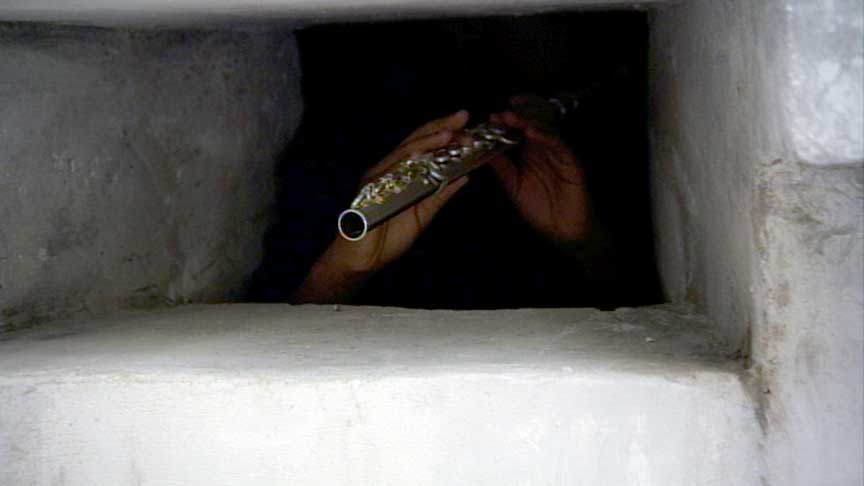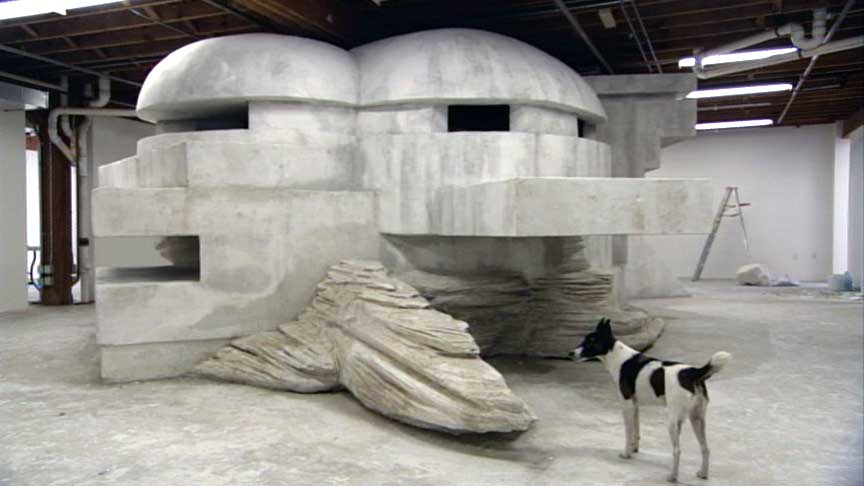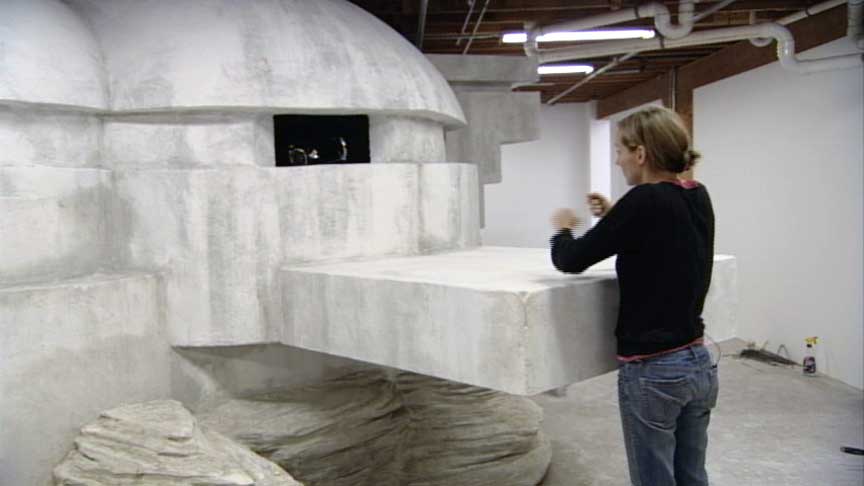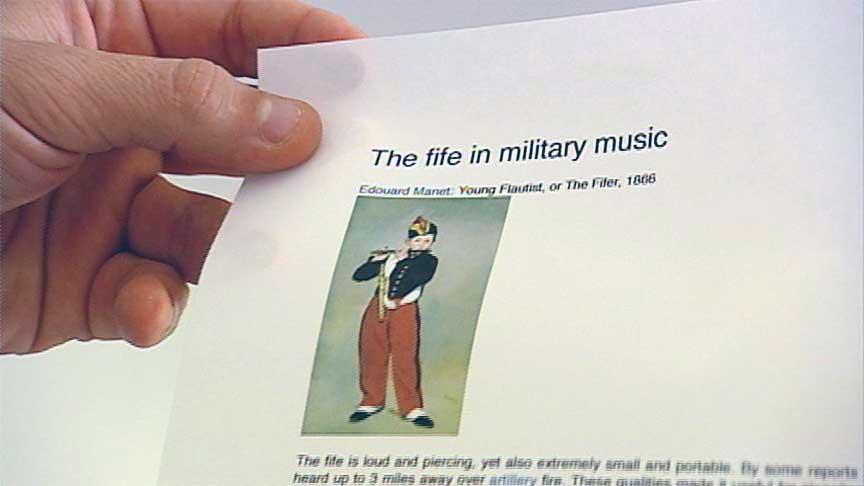Interview
“Clamor” and War Music

Jennifer Allora and Guillermo Calzadilla installing Clamor (2006) at The Moore Space, Miami, FL, 2006. Production still from the Art in the Twenty-First Century Season 4 episode, Paradox. © Art21, Inc. 2007.
Artists and collaborators Jennifer Allora and Guillermo Calzadilla discuss their 2006 installation Clamor.
ART21: Can you talk about your installation, Clamor?
CALZADILLA: We made an archive of war music from different areas of the world and different times: from Chile and Russia to the American Civil War to what the soldiers listen to today in Iraq with their headphones while they’re enduring combat. We juxtapose that over the archival material to make it very complex. We’re not only mixing war music from many eras, but we’re also combining the kinds of music that CNN and Fox News use when they’re doing war announcements. The subject of the work is very much in the title, Clamor. It’s the music of war, music as a weapon, everything that has to do with music and war, in a complex montage that is part of a sculpture in which there’s going to be a concert (the musicians will be inside).
ART21: What interesting uses of music in war did you come across in your research?
CALZADILLA: There are historical moments in which the army had a band playing for the group of people who were fighting. Likewise, the other army had a band. And there were all these codes. For example, there were certain songs that meant “Attack!” or “Retreat!” And there was a moment in which they used that as part of the tactics of war: they played the retreat song, but they’re not retreating. It’s just that the other army understands that, and then they attack. So, there are all these relationships.
ART21: What are some of the more unexpected sounds that made it into the mix?
CALZADILLA: The Futurists: Marinetti (the founder of this literary and art movement and one of the first supporters of the Italian Fascist Party) going, “ra-ta-ta-ta-ta-ta-ta.” Or the Futurist poem, “Onomatopoeia.”

Jennifer Allora and Guillermo Calzadilla installing Clamor (2006) at The Moore Space, Miami, FL, 2006. Production still from the Art in the Twenty-First Century Season 4 episode, Paradox. © Art21, Inc. 2007.
ART21: The installation is made up of both the object that we see and the music that we hear.
CALZADILLA: It’s a sculpture that is basically a concert. The band is made up of live musicians inside this sculpture. It’s like being at a stadium, and the band—instead of playing on the stage—is playing in the bathroom. There are maybe twenty or thirty musicians inside this sculpture, but you cannot see them. You can hear them play, and they’ll be playing war music from different times and places.
ART21: Can you describe the sculptural aspect of the installation?
ALLORA: The sculpture resembles a bunker or a cave, like a piece of the earth with various geological forms. Instead of guns, there are trumpets or flutes sticking out.
ART21: What triggered this piece?
CALZADILLA: What triggered this piece was our interest in how people use music or sound as a weapon: how you can have a gun made of sound that can immobilize you. Then we started getting interested in the relationship between sound or music and war. Our research opened up an enormous quantity of material related to this idea—an incredible archive of sounds related to war—from actual combat, where music was historically used to command and control troops, to more contemporary uses such as propaganda to instill patriotism.

Jennifer Allora and Guillermo Calzadilla installing Clamor (2006) at The Moore Space, Miami, FL, 2006. Production still from the Art in the Twenty-First Century Season 4 episode, Paradox. © Art21, Inc. 2007.
ART21: Can you give an example of the role that music plays in a contemporary context, like the war in Iraq?
CALZADILLA: Today you see soldiers listening to music with their headphones on as they are in combat. And they’re listening to different groups: to speed metal or to hip-hop, et cetera. Each of them has his own CD and her own soundtrack to war, where before you had an entire military band playing the same song for all the soldiers. This is a change in technology, in subjectivity: you now choose your own sound for combat.
ART21: What do you make of this?
CALZADILLA: It’s not about judging, saying “This is bad” or “It’s good.” It’s just a condition. It’s a technological condition. And it’s something that’s a reality, a fact. You can interpret what it means. And it means many different things.
ART21: What do you think the wider implications are?
ALLORA: These conflicts are very large. They involve governments, nations, large groups of people. It affects everyone, everything: the economy, how you relate to others, what you like and what you don’t like. It generates emotions in you, and these emotions then become something concrete: like, the way that you react, the decisions you make, what you support and what you don’t support, what you identify with and what you don’t identify with. These things affect everyone to a certain degree. And then it’s up to you to determine how this thing is going to affect you and how much you’re going to react to it.
ART21: How do you describe the subject of the work?
ALLORA: The subject of the work—it’s very much in the title, Clamor.

Jennifer Allora and Guillermo Calzadilla installing Clamor (2006) at The Moore Space, Miami, FL, 2006. Production still from the Art in the Twenty-First Century Season 4 episode, Paradox. © Art21, Inc. 2007.
ART21: Does your own personal relationship to music come into play here?
ALLORA: For many years, as a kid until I was a teenager, I danced. I guess my relationship to music comes from that. It was all different kinds of dance—tap, jazz, ballet—and I was very much involved in it. Through that I was hearing music all the time. And all different kinds of music too, from classical to jazz.
I think the music part of it makes sense for us to work with because it’s non-verbal. It’s a place that people can identify because it’s not difficult to describe. It’s a sound, and you can identify with that sound. It seems in some ways less complicated than language, for me.
ART21: And because you’re from different language traditions, music is a common thing.
CALZADILLA: Yeah, I speak Spanish and Jennifer speaks English. I was born in Cuba and Jennifer was born, raised, and educated in the United States.
ART21: Collectively you are working with a sonic language that develops its own meaning.
ALLORA: We’re creating really interesting juxtapositions of iconic things that not only sonically create a meaning but also are meaningful in terms of what they represent. Each of these songs is symbolic. Everyone recognizes them as being attached to certain countries and civilizations. So, it’s about that relationship as well.
CALZADILLA: Like, in other works we’ve done—sculpture, video, or photography—you see the juxtaposition of things. You see an image before, an image after, and then you see its relationship. And those things are in opposition to each other. So, it’s sort of the same thing here, but instead of being done with sculpture or video, it’s done exclusively with sound.

Jennifer Allora and Guillermo Calzadilla in their home and studio, San Juan, Puerto Rico, 2006. Production still from the Art in the Twenty-First Century Season 4 episode, Paradox. © Art21, Inc. 2007.
ART21: How do you begin looking for war music anyway?
ALLORA: There’s lots of American patriotic and military music available on the Internet. You know: “Yankee Doodle,” “The Battle Hymn Of The Republic,” “America The Beautiful,” “The Fairest Of The Fair,” “Here’s To America.” But this is just one sliver of it. We wanted to try material from all different countries and historical periods.
ART21: Say more about the significance of the word, Clamor.
ALLORA: Interestingly enough, in the history of military music, one of the ways they describe the instruments’ function on the battlefield is to create a Clamor. They’d create a noise that was so unbearable for the opponent that it would actually distract them and keep them from being able to effectively fulfill their job of fighting.
It’s described by one Crusader as comprising trumpets, clarions, horns, pipes, drums, cymbals—a prodigious array creating a horrible noise and Clamor. And he says they did this to excite the spirit and their courage, for the more violent the Clamor became, the more bold they were for the fray.
We’re trying to reinvigorate this word, to redirect it to a new end in this exhibition. We want to talk about the global state of war of today, something that resonates with contemporary experience.
This interview was originally published on PBS.org in September 2007 and was republished on Art21.org in November 2011.



